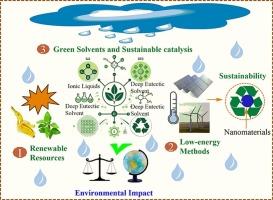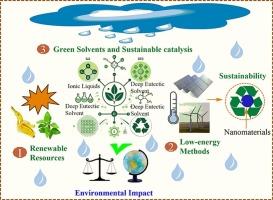功能纳米材料的可持续合成:可再生资源、节能方法、环境影响和循环经济途径
IF 13.2
1区 工程技术
Q1 ENGINEERING, CHEMICAL
引用次数: 0
摘要
传统的纳米材料合成方法往往依赖于有毒试剂和能源密集型工艺,并产生大量危险废物,对环境和人类健康造成严重风险。本综述通过强调创新和可持续的综合方法来解决这些问题,这些方法不仅减少了生态影响,而且与循环经济原则和国际可持续性框架保持一致。作者批判性地讨论了可再生资源的使用,如植物提取物、农业残留物和藻类作为传统化学原料的环保替代品。详细讨论了机械化学、微波辅助和光化学等低能量方法的环境和技术效益。此外,作者还讨论了闭环系统的目的,包括离子液体和深共晶溶剂在内的环保溶剂,以及绿色催化剂,这些都有助于降低对环境的影响。一个比较的生命周期分析提出了评估的优势和权衡不同的合成路线。最后,作者提出了仿生方法、合成生物学和混合系统作为未来利用人工智能发展可持续纳米技术的候选途径。通过对这些问题进行综合和跨学科的研究,本综述为扩大纳米材料的绿色合成和实现地球健康提供了一个全面的路线图。本文章由计算机程序翻译,如有差异,请以英文原文为准。


Sustainable synthesis of functional nanomaterials: renewable resources, energy-efficient methods, environmental impact and circular economy approaches
Conventional nanomaterials synthesis methods often depend on toxic reagents, energy-intensive processes, and produce considerable hazardous waste, causing serious risks to both environmental and human health. This review addresses these concerns by highlighting innovative and sustainable synthesis approaches that not only reduce ecological impact but also align with the circular economy principles and international sustainability frameworks. The authors critically discuss the use of renewable resources, such as plant extracts, agricultural residue, and algae as eco-friendly substitutes for traditional chemical starting materials. The environmental and technological benefits of low-energy methods, such as mechanochemical, microwave-assisted, and photochemical routes, are discussed in detail. Furthermore, the authors discuss the purpose of closed-loop systems, eco-friendly solvents including ionic liquids and deep eutectic solvents, and green catalysts that all contribute towards supplying lower environmental impacts. A comparative life cycle analysis is presented to assess the advantages and trade-offs of different synthesis routes. Finally, the authors proposed biomimetic approaches, synthetic biology, and hybrid systems as candidate paths for future development of sustainable nanotechnology through the utilization of AI. By presenting an integrated and interdiscipline examination of these issues, this review provides a comprehensive roadmap towards expanding green synthesis of nanomaterials and achieving planetary health.
求助全文
通过发布文献求助,成功后即可免费获取论文全文。
去求助
来源期刊

Chemical Engineering Journal
工程技术-工程:化工
CiteScore
21.70
自引率
9.30%
发文量
6781
审稿时长
2.4 months
期刊介绍:
The Chemical Engineering Journal is an international research journal that invites contributions of original and novel fundamental research. It aims to provide an international platform for presenting original fundamental research, interpretative reviews, and discussions on new developments in chemical engineering. The journal welcomes papers that describe novel theory and its practical application, as well as those that demonstrate the transfer of techniques from other disciplines. It also welcomes reports on carefully conducted experimental work that is soundly interpreted. The main focus of the journal is on original and rigorous research results that have broad significance. The Catalysis section within the Chemical Engineering Journal focuses specifically on Experimental and Theoretical studies in the fields of heterogeneous catalysis, molecular catalysis, and biocatalysis. These studies have industrial impact on various sectors such as chemicals, energy, materials, foods, healthcare, and environmental protection.
 求助内容:
求助内容: 应助结果提醒方式:
应助结果提醒方式:


